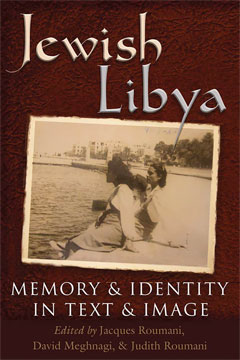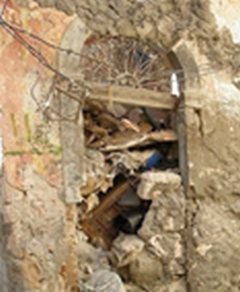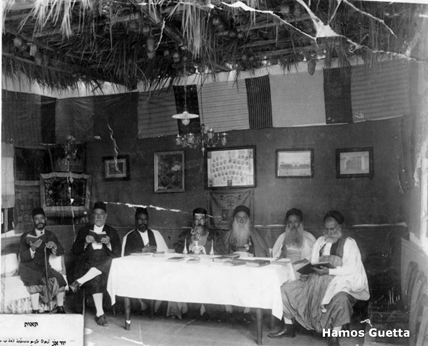Jewish Libya: Memory and Identity in Text and Image
Introduction to the book by Jacques Roumani1
Reviewed by
Lucette Lagnado2

Once upon a time there was a sizeable Jewish community in Libya with
its own culture, institutions, passions and traditions. Does anyone
still remember? Does it even seem possible that Jews resided in that
chaotic, violence-scarred country for centuries and centuries? It is fair
to say the world has all but forgotten the Jews who once called the
Middle East and North Africa their home, so it was with tremendous
wistfulness that I read through this elegiac tribute to those who once
thrived between Tripoli and Benghazi. Jacques Roumani, the lead author,
had made it his life’s work to remember Libyan Jewry -- to enshrine it
so to speak. Though he died sadly only months before publication, this
very elegant book he helped fashion is filled with a range of voices who
offer us both rigorous historical essays and exquisite reminiscences of
the life that was and will never be again. The pieces that form this
book were clearly chosen with great care; they offer an intimate sense
of the pleasures that were part of being a Jew in Libya, along with the
perils and the dangers, especially later, after the creation of Israel
when the Jews who were left were targeted for horrific persecution until
they had to flee en masse to Italy in the 1960s.
 |
A Doorway in the Hara
(Jewish quarter)
of Tripoli, today |
In one essay I found especially poignant, an author recalls stumbling
into a patio where orange flower petals were being distilled: Orange
flower water was an essential part of cooking in the Middle East, even
in making coffee. He describes the sacks of orange flower petals, their
pungent, dizzying scent. Indeed, he “became inebriated from the perfume
of the flowers, the perfume of my childhood.”
That is how I have chosen to remember the Jews of Libya as a result
of this extraordinary, tender book – not the sad ending and flight of
the community, but the times when their world was filled with the
lovely, endearing scent of orange flowers, one of the most heady
perfumes on this earth.
An important and compelling work that manages to be both lyrical and
a serious work of historical scholarship.

Rabbis in sukkah, Tripoli, beginning of twentieth century
Photos courtesy of Hamos Guetta
Part of the Introduction
by
Jacques Roumani
Through a combination of text and image, this
anthology is designed to provide the nonspecialist reader with a
contextual understanding of Jewish Libya and a timely reference to this
vibrant community. It should enrich the Jewish landscape of North
Africa.
Our twelve contributors present very diverse
approaches to various aspects of Libyan Jewish life and culture. It is
important to remember that (as documented by archaeologists) our
collective history reaches far back in time to ancient times. Shimon
Applebaum, a British Israeli archaeologist who was stationed in
Cyrenaica during the British Military Administration (1943–1951), writes
about the Jewish Revolt against Rome in Cyrenaica in 115–117 CE (also
known as the Revolt of the Diaspora) in his chapter “The Jewish Revolt
against the Romans in Cyrenaica, 115–117 CE: Archaeological Evidence,
Causes, and Course of the Revolt.” Applebaum has studied the revolt,
brutally put down, of this large and flourishing ancient Jewish
community, involving Egypt, Cyprus, and Mesopotamia as well as Eretz
Yisrael. The menorah carved on a rock road in Cyrenaica, photographed a
little earlier by an Italian archaeologist during the Fascist period,
and actually a piece of graffiti, is one of the first examples of the
use of the menorah as a political symbol. Survivors of the revolt may
have fled south into the Sahara, eventually leading a defense against
the Muslim invasion and helping create a Berber-Jewish syncretism as far
west as southern Morocco. Applebaum’s chapter is reproduced from his
Jews and Greeks in Ancient Cyrene (1979).3
Maurice M. Roumani sheds light on the long centuries bridging Roman
times and the colonial period (“Libyan Jews in the Islamic Arab and
Ottoman Periods”). When Arabs invaded in the seventh century, they met
organized resistance for a time from Jews and Berbers allied under La
Kahena, the Jewish chieftain-queen. But it failed and the Muslim
invaders swept on as far as Spain. Jewish communities survived,
especially in the Jebel Nafusa Mountains near Tripoli, suffering
persecution again under the Almohads and the Banu Hilal Bedouin invaders
in later centuries. Such sufferings are recorded by poets and discussed
later in our volume by Harvey E. Goldberg. From the sixteenth and
seventeenth centuries under the Ottomans and the local dynasty of the
Qaramanlis, Jews generally recovered and prospered, especially in the
coastal towns, establishing trading links around and across the
Mediterranean that would be invaluable in the Italian colonial period,
as several of our other writers point out.
Hamos Guetta’s evocative piece (“Mafrum, Haraimi, Tebiha, Bsisa,
and Other Culinary Specialities: Tastes, Symbols, and Meaning”)
discussing traditions and food captures life in the old Jewish quarters
of Tripoli, the haras where even in the mid-twentieth century life
seemed to have changed little since Ottoman times. His child’seye view
shows us the world of women, largely excluded from the economic life of
men, but lively with song and tradition and especially the lore and
labor of cooking in their open courtyards. Rachel Simon, later in the
book, confirms many of the insights here from a more academic point of
view.
Harvey E. Goldberg, in a scholarly, anthropological study—
“Tradition with Modernity: From Ottoman Times (1835–1911) to Italian
Encounters (1900–)”—likewise fleshes out these remembered impressions.
He records how, because books were rare, Jewish learning was largely
oral; how the Beth Din of Tripoli had its own versions of Jewish law not
accepted elsewhere but suitable for local conditions; and how local
tradition could trump modernity (in a notorious case of traditional
marriage that led to the firing of Libya’s chief rabbi by the colonial
authorities).
Sumikazu Yoda brings us a linguistic study of the particular
Judeo-Arabic dialect of Tripoli (“Libyan Judeo-Arabic: The Arabic
Dialect and the Judeo-Arabic of the Jews of Tripoli”). Interestingly, he
recorded this dialect in Israel among Libyan Jews who had left Libya in
the late 1940s and early 1950s. Somewhat isolated in Israel within their
ma’abarot, moshavim, or villages, they have preserved Judeo-Arabic
better than those more Italianized Jews who stayed on in Libya and moved
to Italy in 1967. Later on in our volume, Samuele Zarrugh has more to
say on the Jews of Benghazi and their Judeo-Arabic.
From the late 1940s and early 1950s, when Jews began to leave, and
definitively by 1967, when the last of them left, the echoing voices in
Judeo-Arabic and tantalizing scents of food being prepared before each
Jewish holiday were fading away. Jews left behind an urban landscape of
not only the humble homes surrounding open courtyards in the hara, homes
soon occupied by Muslims, but also magnificent synagogues and public and
commercial buildings designed by Jewish architects during the Italian
period. Jack Arbib’s visually rich essay (“The Vanishing Landscape: A
Retrospective Glance at the Topos of Libyan Jews”) documents much of
this with “before” and “after” pictures, depicting a sad story of
neglect, destruction, and desecration. He also indicates the shared
spaces where Jews, Muslims, and even Christians had once interacted.
These shared spaces were themselves largely created during colonial
times.
Rachel Simon, in “Libyan Jewish Women as a Marginalized Vanguard in
the Late Nineteenth and Early Twentieth Centuries,” reveals how women in
a traditional environment could also be modernizers or voices for
continuity and change. She discusses areas in which women could
potentially be active, pinpointing family life, work, education, and
occasional participation in public life.
This paper and the following one complement each other. “Libyan
Jewish Women in Italy and Israel Today,” by Gheula Canarutto Nemni, is
based on interviews with three representative groups of Libyan Jewish
women today: conservative/traditional, middle of the road, and
modernizing. Both essays highlight the enterprising nature of Libyan
Jewish women, the real pillars of their families through the 13
generations, loyal to tradition yet able to serve as a vanguard and
seize opportunities to better the lot of their loved ones. Vivienne
Roumani- Denn’s excerpts from interviews of both women and men in the
following chapter allow us to understand the family from the male point
of view as well. One of her interviewees explains that, within his
family, “Mother was the captain of the ship,” validating the findings of
Simon and Canarutto Nemni. Roumani-Denn’s own mother’s opinion about her
daughter not being free to walk the streets for fear of being bothered
by Muslim males (by the 1950s and 1960s Libyan Jewish women had dressed
in European clothes for decades and were never actually veiled, only
perhaps adding a small headscarf) also reflects comments by the
respondents of Canarutto Nemni.
A cluster of articles on voices, both collective and individual,
follows. In her “Life Interrupted: Interviews with Jews of Libyan
Origin,” Roumani-Denn draws on her archive of recorded interviews.
Libyan Jews fill a wide and diverse spectrum of careers and activities
along traditional and modern lines. Whether successful entrepreneurs,
professionals, leading national and international figures, academics and
artists, or rabbis, they are linked by a common Libyan Jewish experience
that they may or may not view as part of their new identities. A streak
of fearlessness, of risk taking, characterizes not only women but also
Jewish men from Libya and is expressed in extraordinarily successful
careers achieved against all odds. This is accompanied by and stems from
a very high degree of confidence-inducing warmth and love within the
family. The insights by Guetta, Canarutto Nemni, and Simon are confirmed
and echoed through these interviews.
On an individual level, Jacques Roumani’s interview of Samuele
Zarrugh (“Growing Up Jewish in Benghazi: An Interview with Samuele
Zarrugh”) shows a person who comes from a very warm and supportive
family and who thus, with the self-confidence this creates, has been
ready to do extraordinary things. The family did not live in the Jewish
area of Benghazi but somewhat outside it in a Muslim neighborhood.
Samuele attended a Muslim high school and studied business economics at
the University of Benghazi, an unusual course for a Jew in Libya. After
the expulsion in 1967, he and his family did not gravitate to Rome like
the majority but moved to Livorno, a much smaller Jewish community. As a
three-term president of the Jewish Community, he has become a factor in
local affairs. Samuele’s family bears out the paradigms of a close,
loving Jewish family and also shows the closer relationships between
Muslims and Jews in Benghazi than in Tripoli.
Our final section relates to the undeniable sufferings to which
Libyan Jews have been subject. A chapter by Goldberg, “Violence and the
Liturgical/Literary Tradition: Joining the Chorus while Retaining Your
Voice,” presents piyyutim composed to commemorate dangerous
events from which the Jews of Libya escaped; thus these are hymns
thanking God for their deliverance. Such compositions entered the
liturgical tradition of Libyan Jews from the eighteenth century on, and
in some cases they have remained part of it to this day. In other cases,
only a faint memory remains of these rare piyyutim.
“Yossi Sucary’s Novel Benghazi—Bergen-Belsen in the
Context of North African Jewish Literature of the Holocaust,” by Judith
Roumani, introduces a new novel, written originally in Hebrew, which
brings to life the Holocaust experience of several hundred Libyan Jews
with British citizenship who were taken from Libya and interned in
Bergen-Belsen. Other Jews, particularly from Cyrenaica, with French,
Tunisian, or Libyan citizenship, suffered deportation and internment,
either in Tunisia or in the desert of Tripolitania. Those with Italian
citizenship were taken to Italy and placed in camps there. These unknown
stories of the long reach of the Holocaust also deserve to be told.
”Libyan Jews between Memory and History,” by David Meghnagi, the
third coeditor of this volume, in his chapter based on personal memory,
interrogates the relationship between memory and history, aspiring
toward preservation of memory and continuity of identity. Identity is
not only in the present, but depends for its maintenance on memory, and
the memories of Libyan Jews lie in both strong and positive traditions
and the trauma suffered in the land of their origins.
Thus, the combination of a proud and intense religious and
traditional life, a strong family life, and historical trauma, the
editors believe, form the memory and the identity of the Jews of Libya,
and serve as a launchpad for their entry into the ceaselessly changing
modern world as fully modern people.



